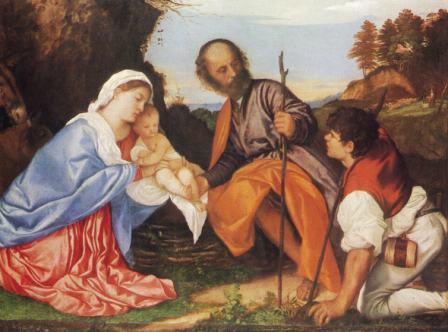Birth of Christ
Birth of Christ
– Father Johann G. Roten, S.M.

As we ponder the Birth of Jesus, we are faced with some noteworthy differences between Luke and Matthew. In Matthew’s Gospel Joseph is the active and central figure, not so in Luke. He is--in Matthew--the recipient of Revelation, which comes to him through the appearance of an angel in a dream. Matthew, contrary to Luke, mentions no residence in Nazareth prior to the birth; yet he coincides with Luke in the statement of the virgin birth and in the childhood residence of Jesus in Nazareth.
But let us look into some of the controversial or problematic aspects of Matthew’s presentation of the birth of Jesus (Mt. 1, 18-25):
1. First of all the expression “espoused” (in 1:18): The written contract of marriage had been drawn up between Joseph (or his parents) and the parents of Mary. The Jewish marriage ceremony was accomplished when the groom took the bride into his house: this is what is meant by the expressions “come together” (1:18) and “take” (1, 20, 24). Lack of premarital continence in these circumstances was not adultery in the full sense of the word, nor was the repudiation of the marriage contract “divorce” (1:19) in the frill sense of the word. Furthermore, it is very doubtful that the vigorous capital penalty of the Mosaic Law and the Talmudic traditions were enforced in New Testament times.
2. Joseph is called “righteous” because of his desire to observe the law. This righteousness is united with an unwillingness to expose his wife, for it lay within his power to repudiate the agreement by signing a declaration in the presence of witnesses, but without stating the reasons in public.
3. The angel of the Lord is the well-known messenger figure of the Old Testament, for example, in Genesis 16:10, 22:11, in Exodus 3,2, Judges 6, 13; 2 Samuel 24,16. In Judges (13,3) the angel of the Lord announces the birth of Samson; here he announces the name of the child: Jesus.
The Greek form Jesus represents the Aramaic Yesua and the Hebrew Yehosua. According to a popular etymology the name means “Yahweh is salvation.”
This child will be an agent of salvation and the people will be saved from their sins, not from external enemies or dangers from nature. The greatest to bear this name in the Old Testament was the hero of the book of Yoshua.
4. Matthew presents the birth of Jesus as the fulfillment of Isaiah 7:14. The formula of “fulfillment” occurs eleven times in this Gospel, more often than in the other three Gospels combined. The expression “fulfillment” does not signify mere prediction and fulfillment, and it is difficult to state in modern terms the kind of thinking involved. Its basic meaning could be circumscribed in the following manner: The saving event of the Gospel gives the word of the Old Testament, which is a declaration of the power and will of God to save, a new dimension of reality.
5. The expression “virgin” in verse 23 is rendered in the Septuaginta with parthenos, “virgin,” to translate the Hebrew word in Is. 7:14 for “young girl” (almah). This gives the text of Isaiah a new dimension of reality, a new fulfillment, because Matthew uses it to affirm the virgin birth. His emphasis, however, seems to be more on the declaration of a savior who shall be called Emmanuel, “God is with us,” than on the word parthenos. The birth initiates the Messianic age of salvation to which the whole Old Testament looks forward. The age begins with the birth of a child. Jesus realizes the presence of God among his people in an entirely new way.
6. Verse 25 (“until she had borne a son”) has caused considerable trouble since the early heresies of the Helvidians and the Jovinians, who concluded from it that Mary and Joseph had marital relations after the birth of Jesus. This implication is not present in the Greek particle (eos), and still less if we suppose a Semitic background of the passage. The New Testament knows nothing of any children of Mary and Joseph. Matthew’s interest here is in the affirmation that Joseph is not the natural father of Jesus, and his language is determined by this interest. The agent of the conception of Jesus is “a Holy Spirit” (1:20). This term is used in the Old Testament to designate God’s mysterious power; it is not used to designate the agent of human conception.
As convincing as may be, the purely exegetical approach will never open our hearts to the living truth of God’s revelation. The Bible remains, to speak with George III, “another damned square thick book.” Without God’s loving and living hand touching our hearts, there would be no Christmas touch in the Gospel perikope about the Nativity. Though I don’t think she was particularly thinking of Christmas, Elizabeth Barrett Browning’s four lines from “Aurora Leigh” have a definite and most appropriate Christmas truth about them:
The earth is crammed with Heaven
And every common bush
Afire with God
But only he who sees, takes off his shoes
The rest sit round it and
Pluck blackberries.
All About Mary includes a variety of content, much of which reflects the expertise, interpretations and opinions of the individual authors and not necessarily of the Marian Library or the University of Dayton. Please share feedback or suggestions with marianlibrary@udayton.edu.
